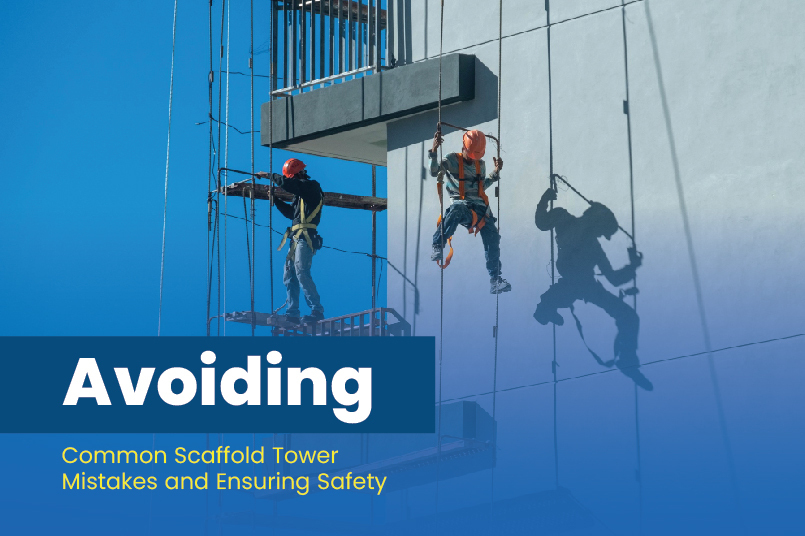
Scaffold towers are a ubiquitous sight in construction and maintenance work, offering a safe and efficient means of accessing elevated areas. However, the benefits of scaffold towers can be swiftly overshadowed by the risks of neglect and ignorance.
This blog will explore the most common mistakes when using scaffold towers and provide valuable safety tips to mitigate them. We also highlight the importance of scaffold safety tags to ensure worksite safety.
Common Scaffold Tower Mistakes
Here is the list of several common mistakes that are encountered while using scaffold towers:
- Introducing Unintended Objects
The temptation to use makeshift solutions, such as chairs or crates, to increase your working height is understandable, but it’s a mistake that should be avoided. Scaffold towers are designed with specific weight and height capacities in mind. Using unintended objects compromises safety and can lead to accidents.
- Battling the Elements
Scaffold towers are built to withstand various environmental conditions, but heavy winds can pose a significant risk. Working on a scaffold tower in high winds is dangerous as it can throw you off balance and result in falling objects. If the weather turns unfavorable, it’s better to delay the work until conditions improve.
- Ignoring Weight Limits
Scaffold towers, like ladders, have weight limits that must not be exceeded. Overloading a scaffold tower with tools or materials can compromise its stability and pose a hazard to those working below. Always adhere to the recommended weight limits to ensure safety.
- Quality Matters
Investing in quality scaffold towers is crucial for safety. Choosing cheaper alternatives might seem cost-effective, but it can jeopardize the stability and durability of the scaffold tower. Prioritize safety and invest in reliable equipment.
- Training and Awareness
Scaffold towers may appear sturdier than ladders, but they have their own limitations. Untrained personnel may not be aware of these limitations and can unknowingly engage in risky behaviors. Proper training is essential to understand safety guidelines and work efficiently on scaffold towers.
- External Hazards
Working at significant heights using scaffold towers can expose workers to external hazards, such as electrical operations. High voltage risks are a serious concern and must be addressed before commencing work. Electrical hazards can lead to fatalities if not managed properly.
Safety Tips for Scaffold Towers
To ensure safe and efficient scaffold uses, here are some essential safety tips:
Safety Equipment and PPE
Always use the necessary safety equipment and personal protective gear (PPE) to protect yourself from falls and accidents.
Understand Load Limits
Familiarize yourself with the weight limits of the scaffold tower and avoid overloading it.
Know Regulations and Standards
Stay updated with construction regulations and industry standards to ensure compliance and safety.
Regular Material Inspection
Regularly inspects the scaffold tower components to identify any signs of wear or damage.
Following the Manual
When assembling a scaffold tower, follow the manufacturer’s manual and guidelines meticulously.
Daily Site and Equipment Inspection
Conduct daily inspections of the worksite and equipment before starting work to identify and address any potential safety concerns.
Vehicle and Equipment Safety
Keep vehicles and heavy equipment away from scaffold towers to prevent accidents caused by unintended collisions.
Stay Organized
Maintain an organized worksite to reduce clutter and minimize the risk of tripping or falling hazards.
Weather Conditions Matter
Be mindful of weather conditions, and avoid working on scaffold towers during adverse weather, such as high winds or rain.
Licensing and Training
Ensure that all scaffold users are properly trained and licensed to operate scaffold towers.
Bonus Tip: Scaffold Safety Tags
Scaffold safety tags are crucial for ensuring the safety of scaffold uses. These tags come in three varieties:
– Green Scaffold Tags: These tags indicate that the scaffold has been examined and is safe to use. They should be attached to all access points upon completion of the initial inspection.
– Yellow Scaffold Tags: Yellow tags indicate specific requirements for safe use, meaning the scaffold has been adjusted to match the current work requirements. However, it may pose safety risks to users.
– Red Scaffold Tags: Red tags signal that the scaffold is dangerous for use and is typically employed when scaffolding is being installed or disassembled.
Scaffold safety tags help in distinguishing the safety levels while working, ensuring that scaffold towers are used safely and efficiently.
Avoiding Mistakes for Safer Construction Works
Scaffold towers play a vital role in construction and maintenance tasks, offering accessibility and safety. By avoiding common scaffold tower mistakes and following safety guidelines, construction workers can significantly reduce the risk of accidents and ensure safer worksites. It’s essential to invest in quality scaffold towers and prioritize safety training to guarantee the well-being of all workers.
Scaffold Supply, a leading supplier and exporter of trusted and durable scaffolding systems in the USA, offers top-notch scaffold components and scaffold towers that meet OSHA regulations. From ringlock scaffold towers to movable and non-movable scaffold towers, Scaffold Supply provides the highest level of safety and reliability. Contact Scaffold Supply for your scaffolding uses and ensure a secure and efficient working environment.











Comments are closed